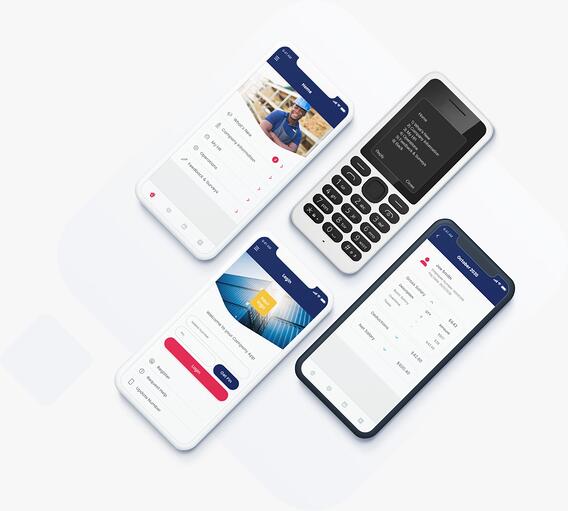An effective internal communication strategy creates better alignment between the organisation and its employees. This is because communication is an integral part of the business value chain.
A good internal communications strategy aims to inspire, engage, inform, and educate frontline and desk-bound employees.
In mining, internal communication has become crucial due to the complexities of this environment, including changing shift schedules, language and cultural barriers, and technological challenges, to name a few.
Let us take a look at what the South African mining industry looks like:
- The South African mining industry employs approximately 450 000 people and contributes about R361.6 billion to the country’s Gross Domestic Product (GDP).
- Approximately 78% of these employees work underground and do not use laptops or desktops as communication tools.
- The 2019 McKinsey report cites digitisation as a critical challenge to the industry.
There are often significant communication gaps between management and mine workers who spend large portions of their days underground.
In this blog, we are going to provide you with a tried and tested step-by-step guide to launching an effective internal communication strategy for the mining sector.
1. Review your existing internal communication strategy
A communication strategy needs to help drive key business objectives; a part of this process is understanding how your existing comms are helping to achieve just that.
Here are a few things you would need to assess before developing a revised internal communication strategy:
- Which channels are you using to deliver company-wide communications?
- Are your communications reaching everyone in your organisation, including frontline employees who are remote and hard to reach?
- Do you have any data or reporting that you can use to measure what messages or content resonated best?
- What environmental factors influence your communications? Consider the needs of different departments, issues around privacy and security, and company priorities or objectives.
- Lastly, consider who needs to be involved in making sure you can implement your communications strategy effectively.
Taking stock of your current strategy and identifying key issues will help you prioritise and address these gaps as your new strategy comes together.
2. Define your audience
This one might seem easy off the bat; they are all the employees who work for your company.
Unfortunately, that is too broad. Most mining operations are very complex, with multiple offices and mines scattered across the globe. To create an effective internal communication strategy, you need to consider the individuals from the desk workers in management, IT, marketing, engineering and HR, all the way to your frontline staff working at the mine, including cleaners, drivers, miners, medical staff and security.
Effective communication is about getting the right message, to the right person, at the right time. Hence, knowing your audience and segmenting or personalising your messaging is vitally important.
Defining your key stakeholders can be done by collating demographic data (age, gender, location, job title) from HR. Additionally, conducting site visits, inter-departmental focus groups or one-on-one interviews with employees will help you uncover more profound insights into the challenges they face.
It is often these challenges, whether they are personal, cultural, economic or technological, that might be preventing your current communication strategy from being effective.
From here, you want to dissect the information and start segmenting and grouping your stakeholders as is appropriate for your organisation.
This is where we start to tailor an internal communication strategy to your workforce. In completing this step, you are arming yourself with the kind of information that can increase engagement, empower your workforce, boost overall satisfaction and increase plant productivity.
3. Define your SMART goals

Internal communication is in service of your company’s goals and objectives. SMART goals are very effective at setting clear parameters for your comms plan and should be very closely aligned to your organisation’s higher-level goals.
Let us unpack what SMART stands for:
Specific – Define your goal in clear and straightforward terms.
Measurable – Add a metric that will be used to measure if your goal has been achieved or not.
Achievable – Ensure your goal is not unrealistic. Setting a number too high can often serve to demotivate your team and set you up for failure.
Relevant – Set a meaningful goal that will have a tangible impact on your team or the business.
Time-bound – Add a date to give your goal a time limit and set a milestone for you to achieve.
Here are some examples of good SMART goals:
- Increase our employee Net Promoter Score (eNPS) from 7 – 9 by the 1st of June 2022.
- Decrease safety-related incidents by 5% by the end of Q3, 2021.
- Increase frontline employee survey participation from 30% to 50% by 30 November 2021.
Setting SMART goals can ensure that your communications strategy has a real and measurable impact on your overall business and employees.
4. Pick your internal communication channels
 Using the right channels to connect with your intended audience is the cornerstone of effective communication. When considering which channels to use, you need to make sure that you pick an appropriate format for the type of message you want to send and the audience you want to reach.
Using the right channels to connect with your intended audience is the cornerstone of effective communication. When considering which channels to use, you need to make sure that you pick an appropriate format for the type of message you want to send and the audience you want to reach.
Here is a list of 6 communication channels for you to consider:
- Email – Email has traditionally been the go-to medium for corporate communications. Still, it has fallen out of favour in recent years due to the amount of clutter in most inboxes and the fact that email is not effective at reaching all frontline workers.
- Employee App – An employee engagement mobile app can be a very effective tool because it can facilitate various functions, including sending alerts, sharing content and updates, and receiving employee feedback.
- Mobi Site – Mobi sites are an alternative to employee apps where a dedicated corporate mobile site is built and integrated with various business functions, including HR, operations and production systems.
- Unstructured Supplementary Service Data (USSD) – USSD establishes a real-time two-way connection which makes it more responsive than SMS. It is perfect for frontline employees, like miners, in remote locations who do not necessarily have access to computers, the internet, or smartphones. USSD allows staff to use their feature phones to engage with campaigns and content and submit survey responses.
- Meetings – Meetings are arguably the lifeblood of any organisation and effective at disseminating information and fostering collaboration. But, meetings can lead to additional travel expenses, usually only focus on top-down communication, can be disruptive to a production schedule and can only reach a limited number of attendees.
- Displays – Screens provide a dynamic way of sharing information with video and images. By strategically placing them in high traffic areas, like break rooms and entryways, it is easy to reach a large audience. This, however, does not guarantee that all employees will see it and should not be solely relied on when communicating essential or time-sensitive information.
5. Define your content strategy
You have now come to understand the key challenges your workforce is facing, you know which channels you will be using and how you will measure your success.
Now we get to build the content plan:
- What are the core messages you want to communicate?
- What formats can be used to engage your workforce creatively?
- Is there an action you would like the recipient to take?
- Which channel(s) make the most sense for a particular message?
- How frequently will you schedule content?
It is important to keep in mind not to overburden your workforce with too many comms. Keeping the message clear and straightforward, and making it easy for your workforce to respond to is essential. After all, communication should be a two-way street.
6. Review and launch
At this point, you should be equipped with a clear internal communication strategy that is ready to be rolled out to your workforce. It is time to do all your final checks, testing and changes. Then it is time to push play.
7. Track, Measure and Report your success
In step 3 of this blog, we mapped out some goals to help you track the efficacy of your communications plan. Make sure that once your communications start to go out that you are including measuring and reporting features in your overall strategy.
You could look at incorporating monthly or quarterly reporting sessions where leadership has the opportunity to discuss what has been done, key metrics, and whether or not you are on track to achieving the goals you set out initially.
Sessions like these should also incorporate any new tactics you plan on implementing to help achieve your strategic objectives.
Internal communication key takeaways
There is, unfortunately, no one-size-fits-all when it comes to effective internal communications. Reaching a large workforce that operates in varying situations from behind a desk or the bottom of a mine shaft can be challenging.
The more you can understand the different groups of desk-bound and frontline workers, the better you will understand their challenges and how to connect with them.
Ready to engage your mine worker? Speak to one of our mining experts today.
Unleash Tomorrow

